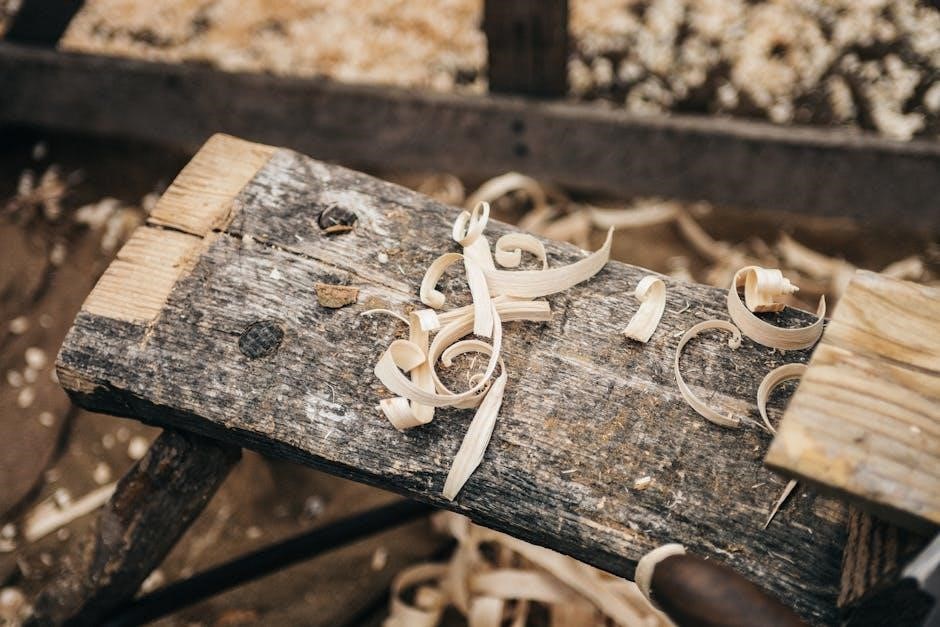Overview of Band Saw Guide Bearings
Band saw guide bearings are essential components that ensure accurate blade tracking and stability during cutting. They come in various types, including roller bearings and block guides, designed to support the blade and maintain precise alignment. Properly functioning guide bearings are crucial for achieving smooth cuts and extending the lifespan of the bandsaw blade.
Importance of Proper Guide Bearings in Bandsaw Operations
Proper guide bearings are vital for optimal bandsaw performance. They prevent blade drift, ensuring straight and accurate cuts. Misaligned or worn bearings can lead to uneven cuts, increased vibration, and premature blade wear. Regular maintenance and adjustment of guide bearings are essential to maintain peak performance and safety during operations.
Band saw guide bearings are critical components that support and align the saw blade, ensuring precise cuts and smooth operation. These bearings are typically located near the blade’s path and work in conjunction with guide blocks or rollers to maintain proper blade tracking. They are designed to minimize friction and wear while withstanding the stresses of cutting various materials. Properly functioning guide bearings are essential for achieving accurate results and extending the lifespan of both the blade and the bandsaw. Regular maintenance, such as lubrication and adjustment, is necessary to ensure optimal performance. High-quality bearings, like those from reputable manufacturers such as Carter, are often recommended for their durability and reliability.
Proper guide bearings are essential for ensuring precise blade alignment, reducing vibration, and preventing blade drift during bandsaw operations. When guide bearings are correctly adjusted and maintained, they minimize wear on the blade and extend its lifespan. Misaligned or worn bearings can lead to uneven cuts, increased noise, and potential damage to the bandsaw. Additionally, proper guide bearings enhance safety by maintaining consistent blade tracking, reducing the risk of accidents. They also improve overall cutting efficiency, allowing for smoother and more accurate results. Regular inspection and adjustment of guide bearings are critical to maintaining optimal performance and ensuring reliable operation of the bandsaw.

Types of Band Saw Guide Bearings
Band saw guide bearings are available in three primary types: roller bearings, block guides, and combination systems. Roller bearings reduce friction and ensure smooth blade movement, while block guides provide solid support for straight cuts. Combination systems offer the benefits of both, enhancing versatility for various cutting tasks. Each type is designed to optimize blade alignment, stability, and overall performance, catering to different operational needs and preferences. Proper selection ensures efficient and accurate cutting experiences.
Roller Bearings
Roller bearings are a popular choice for band saw guide systems due to their ability to reduce friction and provide smooth blade movement. These bearings are designed with cylindrical rollers that allow for consistent blade alignment and minimal wear. They are ideal for high-precision cutting tasks and are often preferred for their durability and low-maintenance requirements. Roller bearings are typically constructed from high-quality materials, such as steel, ensuring long-lasting performance. Regular lubrication is essential to maintain optimal functionality and extend the lifespan of the bearings. Their ability to support the blade without causing excessive drag makes them suitable for both straight and curved cuts, enhancing versatility in various woodworking applications. Roller bearings are a reliable and efficient option for achieving accurate and consistent results in bandsaw operations.
Block Guides
Block guides are a traditional and robust option for bandsaw guide systems, known for their simplicity and durability. These guides typically consist of a solid block of material, often graphite or ceramic, that provides lateral support to the blade. Unlike roller bearings, block guides offer a fixed point of contact, which can reduce blade wear over time. They are particularly effective for straight cuts and are favored for their ability to maintain consistent blade alignment. Block guides are less prone to seizing compared to bearings and require minimal maintenance. However, they may offer slightly less precision for intricate curved cuts. Their straightforward design makes them a reliable choice for many woodworking applications, especially when paired with proper adjustment and blade tensioning techniques.
Combination Guide Systems
Combination guide systems blend the benefits of roller bearings and block guides, offering enhanced versatility for bandsaw operations. These systems typically feature roller bearings for smooth blade movement and block guides for added lateral support. This hybrid approach ensures minimal friction while maintaining precise blade alignment, making it ideal for both straight and curved cuts. Combination guides are often used in high-performance bandsaws, providing superior accuracy and reducing blade wear. They are particularly favored by professionals who require consistent results across various cutting tasks. By integrating the strengths of both bearing and block systems, combination guides deliver a balanced solution for optimal performance and durability, catering to a wide range of woodworking applications.

Key Features of Band Saw Guide Bearings
Band saw guide bearings are designed for precision, durability, and smooth operation. Key features include adjustability to accommodate different blade sizes, high-quality materials for longevity, and reduced friction for consistent performance.
Adjustability and Precision
Adjustability is a critical feature of band saw guide bearings, allowing precise alignment with various blade sizes and types. Proper adjustment ensures minimal blade deflection, promoting straight cuts and reduced wear. Precision engineering in guide bearings enables consistent performance, while easy-to-use mechanisms facilitate quick setups. This adaptability is essential for handling diverse materials and cutting styles, ensuring accuracy and efficiency in woodworking and metalworking applications.
Durability and Material Quality
Durability and material quality are paramount for band saw guide bearings, as they endure constant friction and heavy-duty cutting operations. High-quality bearings are typically constructed from hardened steel or ceramic-coated materials, ensuring resistance to wear and corrosion. Durable guide bearings maintain consistent performance over time, minimizing blade wobble and misalignment. Premium materials also reduce the risk of premature wear, extending the lifespan of both the bearings and the bandsaw blade. Properly manufactured bearings with tight tolerances ensure smooth operation, while robust designs withstand the rigors of industrial and woodworking applications. Investing in durable, high-quality guide bearings is essential for maintaining precision and reliability in bandsaw operations.
Smooth Operation and Reduced Friction
Smooth operation and reduced friction are critical for optimal bandsaw performance. High-quality guide bearings minimize blade drag, ensuring effortless tracking and consistent cuts. Bearings with advanced materials, such as hardened steel or ceramic coatings, significantly reduce friction, allowing the blade to glide smoothly. Proper lubrication further enhances performance by eliminating heat buildup and wear. Reduced friction also lowers vibration, improving accuracy and extending the blade’s lifespan. Smooth operation ensures quieter running and better control, making precise cuts easier to achieve. By combining durable materials and precise engineering, modern guide bearings deliver exceptional performance, enabling seamless operation for both straight and curved cuts. Regular maintenance, including lubrication, is essential to sustain this smooth functionality over time.

How to Choose the Right Guide Bearings
Selecting the right guide bearings involves considering blade size, type, and thickness, as well as compatibility with your bandsaw model. Opt for durable materials.
Considerations for Blade Size and Type
Choosing the right guide bearings depends on the size and type of your bandsaw blade. Blade thickness, width, and material play a crucial role in selecting appropriate bearings. Thicker blades require bearings with greater clearance to prevent excessive wear, while thinner blades need precise alignment to avoid damage. Additionally, blades designed for curved cuts may require specialized guide systems to maintain accuracy. The material of the blade, such as carbon steel or bimetal, also influences the choice, as harder materials may demand more durable bearings. Ensuring compatibility between blade characteristics and guide bearings is essential for optimal performance and longevity of the bandsaw.
Compatibility with Your Bandsaw Model
Ensuring compatibility between guide bearings and your bandsaw model is crucial for proper functionality. Different bandsaws, such as Craftsman, Jet, or Laguna, may require specific types of bearings or guide systems. For instance, some models use ball-bearing guides, while others rely on block guides or combination systems. Carter guides are often recommended for their compatibility with various models, but they can be costly. It’s important to verify the specifications of your bandsaw to select bearings that fit correctly. Using incompatible bearings can lead to poor blade alignment, increased wear, or reduced performance. Always consult your bandsaw’s owner’s manual or contact the manufacturer for guidance on selecting the right guide bearings for your specific model.
Brand and Manufacturer Reputation
When selecting band saw guide bearings, considering the brand and manufacturer reputation is essential. Reputable brands like Carter Guides are well-known for producing high-quality, durable bearings that enhance performance; These manufacturers often invest in research and development to ensure their products meet precise standards. Established brands typically offer better materials, superior craftsmanship, and reliable customer support. While cheaper alternatives may exist, they often compromise on quality, leading to shorter lifespan and suboptimal performance. Prioritizing trusted manufacturers ensures you receive bearings designed for longevity and compatibility with your bandsaw model. Always research the brand’s history and user reviews to make an informed decision.

Installation and Setup
Installing band saw guide bearings requires precise alignment and careful adjustment. Loosen the guide assembly, position it to align with the blade, and tighten gradually to ensure proper fit and function.
Step-by-Step Installation Guide
Begin by preparing the necessary tools and ensuring the bandsaw is unplugged for safety. Remove the old bearings and clean the mounting area thoroughly. Install the new bearings by aligning them with the blade and securing them firmly. Tighten the adjustment screws gradually, ensuring even pressure. Use a wrench to finalize the tightness, then lubricate the bearings to reduce friction. Perform a test cut to ensure proper alignment and smooth operation. Adjust as needed to achieve optimal blade tracking and stability.
Alignment Tips for Optimal Performance
Proper alignment of band saw guide bearings is crucial for achieving precise cuts and extending blade life. Start by ensuring the blade is centered between the upper and lower guides. Adjust the bearings so they maintain consistent clearance on both sides of the blade. Use a combination square to verify the blade’s alignment with the saw’s table. Loosen the adjustment screws slightly, then gently move the blade into position before retightening. This ensures even pressure and prevents blade drift. Regularly check and adjust the alignment to account for wear or changes in blade tension; Proper alignment not only improves cut quality but also reduces vibration and noise during operation.
Tools Required for Proper Setup
Setting up band saw guide bearings requires specific tools to ensure accuracy and avoid damage. An Allen wrench or open-end wrench is essential for adjusting the guide bearings and tensioning bolts. A screwdriver may be needed for loosening or tightening mounting screws. A combination square or ruler can help verify the blade’s alignment with the guides. Lubrication, such as light oil or silicone spray, is necessary to keep bearings running smoothly. Additionally, a pair of gloves and safety goggles should be worn to protect against sharp blades and debris. Having the correct tools on hand ensures a safe and precise setup process, preventing damage to both the bearings and the bandsaw.

Maintenance and Lubrication
Regular cleaning and lubrication of band saw guide bearings are crucial for smooth operation. Use light oil or silicone spray to keep bearings lubricated and free from debris. Proper maintenance ensures prolonged lifespan and optimal performance of the bandsaw.
Regular Cleaning and Inspection
Regular cleaning and inspection of band saw guide bearings are essential to ensure optimal performance and longevity. Use compressed air or a soft-bristle brush to remove dust, debris, and metal shavings from the bearings and surrounding areas. Inspect the bearings for signs of wear, such as scoring, pitting, or excessive play; Lubricate the bearings periodically with a light machine oil or silicone-based spray to reduce friction and prevent corrosion. Replace any damaged or worn-out bearings promptly to avoid blade misalignment and poor cutting results. Regular maintenance helps maintain precise blade tracking and ensures smooth, consistent operation of the bandsaw.
Lubrication Techniques for Longevity
Proper lubrication of band saw guide bearings is crucial for extending their lifespan and ensuring smooth operation. Use a light machine oil or silicone-based spray to lubricate the bearings, applying a small bead directly to the moving parts. Avoid over-lubrication, as excess oil can attract dust and debris. For bearings with seals, apply a few drops of oil to the external bushing and let it sit before wiping off any excess. Regular lubrication reduces friction, prevents corrosion, and maintains precise blade alignment. Lubricate after cleaning and before extended periods of heavy use for optimal performance and durability. This simple maintenance step significantly enhances the longevity of your guide bearings.
Replacing Worn-Out Bearings
When band saw guide bearings show signs of wear, such as blade drift or excessive noise, replacement is essential to maintain precision and safety. Start by disconnecting the power and removing the blade. Use specialized tools to remove the old bearings, ensuring the area is clean and free of debris. Install the new bearings, aligning them properly with the blade and guide system. Tighten them securely but avoid over-tightening, which can cause friction. Apply a light coat of machine oil to the new bearings for smooth operation. Regular inspection and timely replacement of worn bearings are critical to prevent damage to the blade and ensure consistent cutting performance.

Troubleshooting Common Issues
Common issues with band saw guide bearings include blade drift, misalignment, and excessive noise. These problems often stem from worn or improperly adjusted bearings. Regular lubrication and precise adjustments can resolve these issues effectively.
Addressing Blade Drift and Misalignment
Blade drift and misalignment are common issues that can affect the accuracy of your bandsaw cuts. Drift occurs when the blade veers off course during operation, often due to improper guide bearing adjustment or uneven tension. To address this, ensure the guide bearings are properly aligned and adjusted to provide consistent support without restricting the blade. Check the tension of the blade, as insufficient tension can exacerbate drift. Misalignment can also arise from worn or damaged bearings, which should be replaced promptly. Use a square to verify the alignment of the blade and guides relative to the table. Regularly inspect and adjust the bearings to maintain precise cuts and prevent further issues. Proper setup and maintenance are key to minimizing blade drift and ensuring optimal performance.
Fixing Excessive Noise or Vibration
Excessive noise or vibration in a bandsaw often indicates issues with the guide bearings or blade alignment. Start by checking the guide bearings for proper adjustment and lubrication. Worn or loose bearings can cause friction and noise, so ensure they are securely fastened and free from debris. Inspect the blade for damage or uneven wear, as this can also contribute to vibration. Additionally, verify that the blade is properly tensioned and aligned with the guides. If noise persists, consider replacing worn bearings or adjusting the guide system to ensure smooth operation. Regular maintenance and proper setup are key to minimizing noise and vibration, ensuring a safer and more efficient cutting experience.
Resolving Tensioning Problems
Tensioning issues can significantly affect bandsaw performance, leading to blade drift or uneven cuts. To resolve these problems, start by checking the blade tension using a tension gauge, ensuring it falls within the recommended range (typically 15,000 to 30,000 PSI for most blades). Adjust the tension knob gradually, monitoring the blade’s alignment. If the blade is too loose, it may wander, while overtightening can cause excessive wear on the guide bearings. After adjusting, test the saw at a low speed to ensure proper tracking. Regularly inspect and clean the tensioning mechanism to prevent dirt or debris from interfering with its function. Proper tensioning is crucial for maintaining blade stability and achieving precise cuts. Always refer to your bandsaw’s manual for specific guidance on tension adjustment.

Advanced Tips for Better Performance
Customizing Guide Bearings for Specific Tasks
Customizing guide bearings for specific tasks enhances precision and versatility. Adjust bearing clearance and alignment to suit different blade types and cutting requirements, ensuring optimal performance.
Upgrading to High-Performance Bearings
Upgrading to high-performance bearings improves durability and reduces friction. Consider advanced materials like ceramic or precision-ground steel for smoother operation and extended lifespan of your bandsaw.
Using Bearing Guides for Curved Cuts
Bearing guides excel in curved cuts by maintaining consistent blade contact. Ensure proper alignment and minimal side pressure to achieve precise, fluid curves in your workpieces.
Customizing guide bearings for specific tasks can significantly enhance your bandsaw’s performance. By adjusting the bearing clearance and alignment, you can optimize the system for different blade types and cutting requirements. For example, tighter bearings may be preferred for thin blades to prevent deflection, while looser settings might accommodate thicker blades. Additionally, aftermarket guide bearings, such as Carter guides, offer superior durability and adjustability, making them ideal for demanding projects. Customization also allows you to address specific cutting styles, such as curved or straight cuts, ensuring precise control and minimal wear on the blade. Proper customization requires careful measurement and adjustment to achieve optimal results.
Upgrading to high-performance bearings can significantly enhance your bandsaw’s efficiency and precision. Modern bearings, such as those from reputable brands like Carter, offer superior durability and adjustability, making them ideal for demanding tasks. High-performance bearings often feature advanced materials and designs that reduce friction and wear, ensuring smoother operation and longer blade life. When upgrading, consider bearings with adjustable preload and precise alignment capabilities, as these can be tailored to your specific cutting needs. Additionally, look for bearings designed for low vibration and noise reduction, which can improve overall cutting accuracy. Investing in high-quality bearings not only improves performance but also extends the lifespan of your bandsaw, making it a worthwhile upgrade for serious woodworkers and professionals.
When performing intricate curved cuts with a bandsaw, proper bearing guide setup is crucial for smooth, accurate results. Adjustable guide bearings allow for precise blade positioning, minimizing wobble and ensuring consistent contact with the workpiece. Roller bearings are particularly effective for curved cuts, as they provide excellent support and reduce friction. For tighter radii, consider using specialized block guides or combination systems that offer added stability. Proper tensioning and alignment of the blade are essential to prevent drift during curved cuts. Regularly inspect and clean the bearings to maintain optimal performance. With the right setup and tools, bearing guides can help you achieve professional-grade curved cuts effortlessly.

Safety Precautions
Always handle sharp bandsaw blades with care, using gloves and protective eyewear. Avoid over-tightening guide bearings, as this can cause blade misalignment or damage. Ensure proper safety measures during maintenance, such as disconnecting power and securing loose clothing.
Proper Handling of Sharp Blades
Handling sharp bandsaw blades requires extreme caution to prevent injuries. Always wear protective gloves and eyewear when touching or adjusting the blade. Ensure the blade is secure and properly tensioned before handling. Avoid touching the cutting edges directly, as they can cause deep cuts. Use a blade wrench or similar tool to grip the blade firmly. When storing blades, keep them in a dry, protected area away from direct contact. Regularly inspect blades for damage or dullness, as these can lead to unpredictable behavior during cutting. Always maintain a clean and clutter-free workspace to minimize accidents. Never handle sharp blades near loose clothing or long hair that could get caught. Stay focused and avoid distractions while working with the blade to ensure safety.

Avoiding Over-Tightening of Bearings
Over-tightening band saw guide bearings can lead to increased friction, heat buildup, and premature wear on moving parts. Always follow the manufacturer’s torque specifications for bearing adjustment. Use a torque wrench to ensure precise tightening, avoiding excessive force. Check bearings regularly for proper alignment and tension. If bearings feel overly restrictive or cause blade binding, they may be over-tightened. Loosen them slightly and test the blade’s movement. Properly adjusted bearings should allow smooth blade operation without resistance. Over-tightening can also lead to reduced cutting accuracy and increased risk of blade breakage. Always perform a test cut after adjusting bearings to ensure optimal performance and safety.
Safety Measures During Maintenance
When performing maintenance on band saw guide bearings, prioritize safety to avoid injuries. Always unplug the bandsaw from the power source before starting work to prevent accidental startups. Wear protective gloves and safety goggles to protect against sharp edges and debris. Use appropriate tools for adjustments and avoid applying excessive force, which could cause sudden movements. Ensure the work area is clear of clutter and well-lit to maintain visibility. Never wear loose clothing or jewelry that could get caught in moving parts. If working with sharp blades, handle them with care, using a blade clamp or similar tool. Keep children and bystanders away during maintenance. Always follow the manufacturer’s guidelines for safe practices.
Band saw guide bearings are crucial for precise cuts and blade longevity. Proper selection, maintenance, and safety ensure optimal performance and durability, supporting various cutting tasks effectively.
Final Thoughts on Band Saw Guide Bearings
Future Trends in Guide Bearing Technology
Advancements in materials science and engineering are expected to revolutionize band saw guide bearings. Future trends may include the development of self-lubricating bearings, reducing maintenance needs. Smart bearings with integrated sensors could monitor wear and alignment in real-time, optimizing performance. Additionally, eco-friendly materials and energy-efficient designs may become standard. Customizable bearings tailored to specific cutting tasks could enhance versatility. Automation in bearing adjustment and alignment is another promising area, minimizing manual intervention. These innovations aim to improve precision, durability, and user convenience, making bandsaws more adaptable to evolving industrial and woodworking demands.
